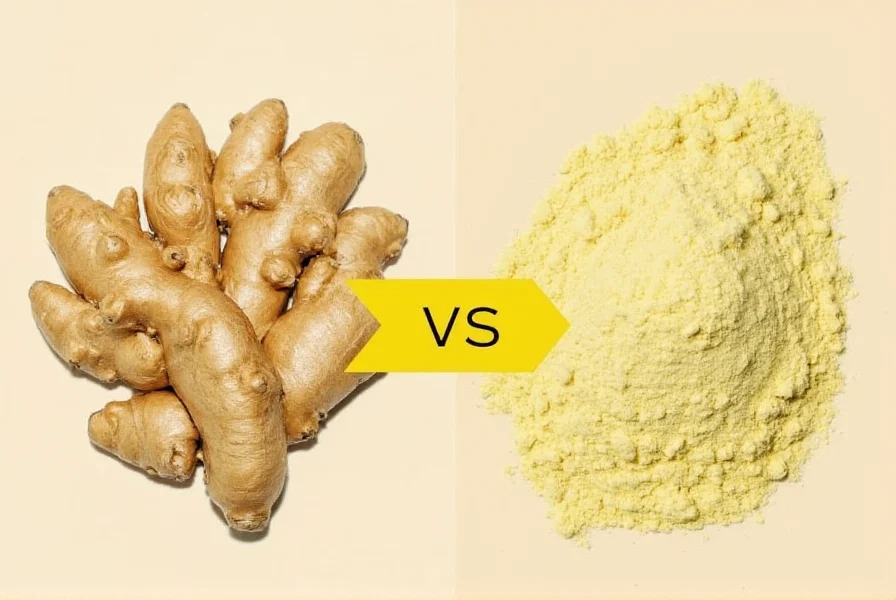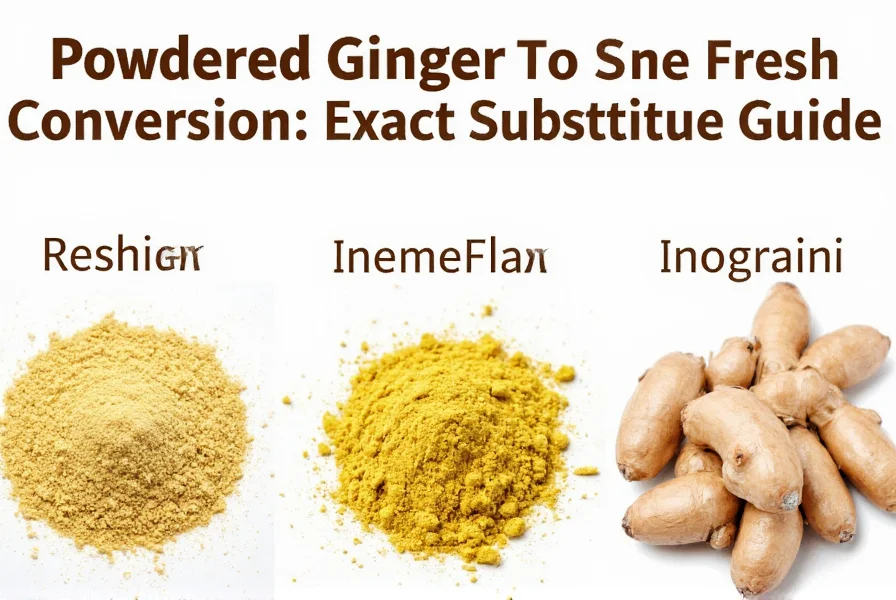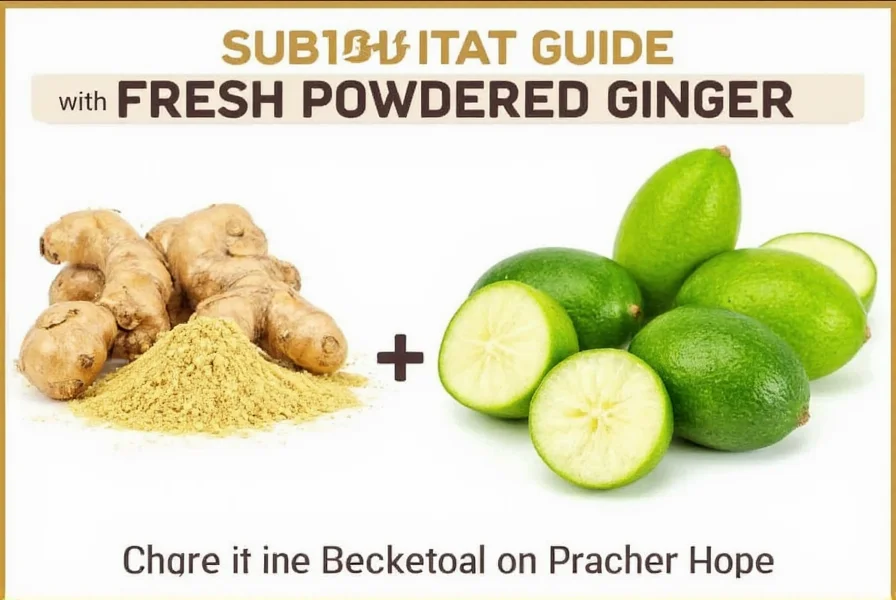Understanding how to properly substitute powdered ginger for fresh is essential for home cooks and bakers who find themselves without the exact ingredient called for in a recipe. While both forms come from the same rhizome, their flavor profiles and potency differ significantly due to the dehydration process that creates powdered ginger.
Understanding the Flavor Differences
Fresh ginger offers a bright, zesty, and slightly spicy flavor with citrus notes. It contains gingerol, the compound responsible for its characteristic heat. When ginger is dried and ground into powder, gingerol partially converts to zingerone, creating a warmer, more mellow, and slightly sweeter flavor profile.
This chemical transformation means powdered ginger lacks the vibrant, sharp bite of fresh ginger but provides more consistent flavor throughout a dish. In recipes where ginger plays a supporting role rather than a starring one, the substitution works particularly well.
| Recipe Quantity of Fresh Ginger | Equivalent Powdered Ginger |
|---|---|
| 1 teaspoon fresh ginger | 1/16 teaspoon powdered ginger |
| 1 tablespoon fresh ginger | 1/4 teaspoon powdered ginger |
| 1/4 cup fresh ginger | 1 teaspoon powdered ginger |
| 1/2 cup fresh ginger | 2 teaspoons powdered ginger |
| 1 cup fresh ginger | 1 tablespoon powdered ginger |
When Powdered Ginger Works Best as a Substitute
Certain cooking applications handle the powdered-to-fresh substitution better than others. Baked goods like gingerbread, cookies, and spice cakes typically respond well to powdered ginger substitution since the dry ingredient integrates easily with other dry components.
Similarly, in spice blends, rubs, and dry marinades, powdered ginger distributes more evenly than fresh. This makes it ideal for curry powders, chai spice mixes, and dry rubs for meats.

Situations Where Fresh Ginger Is Preferable
Some recipes truly benefit from the unique qualities of fresh ginger that powdered cannot replicate. Dishes where ginger is a featured ingredient—such as stir-fries, fresh sauces, ginger tea, or sushi accompaniments—typically deliver better results with fresh ginger.
The bright, pungent quality of freshly grated ginger provides a flavor dimension that powdered ginger lacks. In beverages like ginger ale or fresh juices, the vibrant zing of fresh ginger creates a more authentic experience. Similarly, in Asian cuisine where ginger often appears in recognizable slices or matchsticks, the texture matters as much as the flavor.
Practical Tips for Successful Substitution
When substituting powdered ginger for fresh in your recipes, consider these professional kitchen tips for optimal results:
- Adjust to taste: Start with the conversion ratio, then taste and adjust as needed since personal preference and recipe specifics may require fine-tuning
- Reconstitute when possible: For recipes with liquid components, mix powdered ginger with a small amount of warm water (1:3 ratio) and let sit for 5 minutes before adding
- Consider freshness: Powdered ginger loses potency over time; replace spices older than 6-12 months for best flavor impact
- Balance moisture: In baking, reduce other liquids slightly when substituting powdered for fresh ginger to account for the moisture difference
Storage Considerations for Both Forms
Understanding proper storage extends the shelf life and maintains the flavor integrity of both ginger forms. Fresh ginger root keeps best when stored in a paper bag in the refrigerator's vegetable drawer, where it can last 2-3 weeks. For longer storage, freeze whole or grated ginger in an airtight container.
Powdered ginger maintains optimal flavor for 6-12 months when stored in an airtight container away from heat and light. Exposure to humidity causes clumping and flavor degradation. To test if your powdered ginger still has potency, rub a small amount between your fingers—if the aroma is weak, it's time for a replacement.

Special Considerations for Baking and Cooking
Baking requires more precise measurements than cooking, making the powdered-to-fresh ginger substitution particularly important to get right. In cake batters and cookie doughs, the conversion ratio should be followed precisely, as ginger affects both flavor and chemical reactions in baked goods.
For savory cooking applications like soups, stews, and sauces, the substitution offers more flexibility. Add powdered ginger early in the cooking process to allow its flavor to distribute evenly, whereas fresh ginger can be added at different stages depending on the desired intensity.
Frequently Asked Questions
Can I use powdered ginger instead of fresh in ginger tea?
While you can substitute powdered ginger in tea, the flavor profile differs significantly. For ginger tea, use 1/8 teaspoon powdered ginger per cup of hot water as a substitute for one 1-inch piece of fresh ginger. The resulting tea will be less bright and zesty but still provides warming benefits.
Why does powdered ginger require less quantity than fresh?
Powdered ginger requires less quantity because the dehydration process concentrates the flavor compounds. Fresh ginger contains about 70% water, which evaporates during drying, resulting in a more potent spice by volume. This concentration is why the standard conversion is 1/4 teaspoon powdered ginger for every tablespoon of fresh.
Does substituting powdered ginger affect recipe texture?
Yes, substituting powdered ginger can affect texture in some recipes. Fresh ginger adds moisture that may impact baked goods' consistency. When substituting in baking, reduce other liquids by 1-2 teaspoons per tablespoon of ginger replaced. In savory dishes, the texture difference is usually negligible.
Can I make my own powdered ginger from fresh?
Yes, you can make homemade powdered ginger by thinly slicing fresh ginger, dehydrating until brittle (at 135°F for 8-12 hours), then grinding to a fine powder in a spice grinder. Store in an airtight container away from light. Homemade powder has superior flavor but shorter shelf life than commercial products.











 浙公网安备
33010002000092号
浙公网安备
33010002000092号 浙B2-20120091-4
浙B2-20120091-4